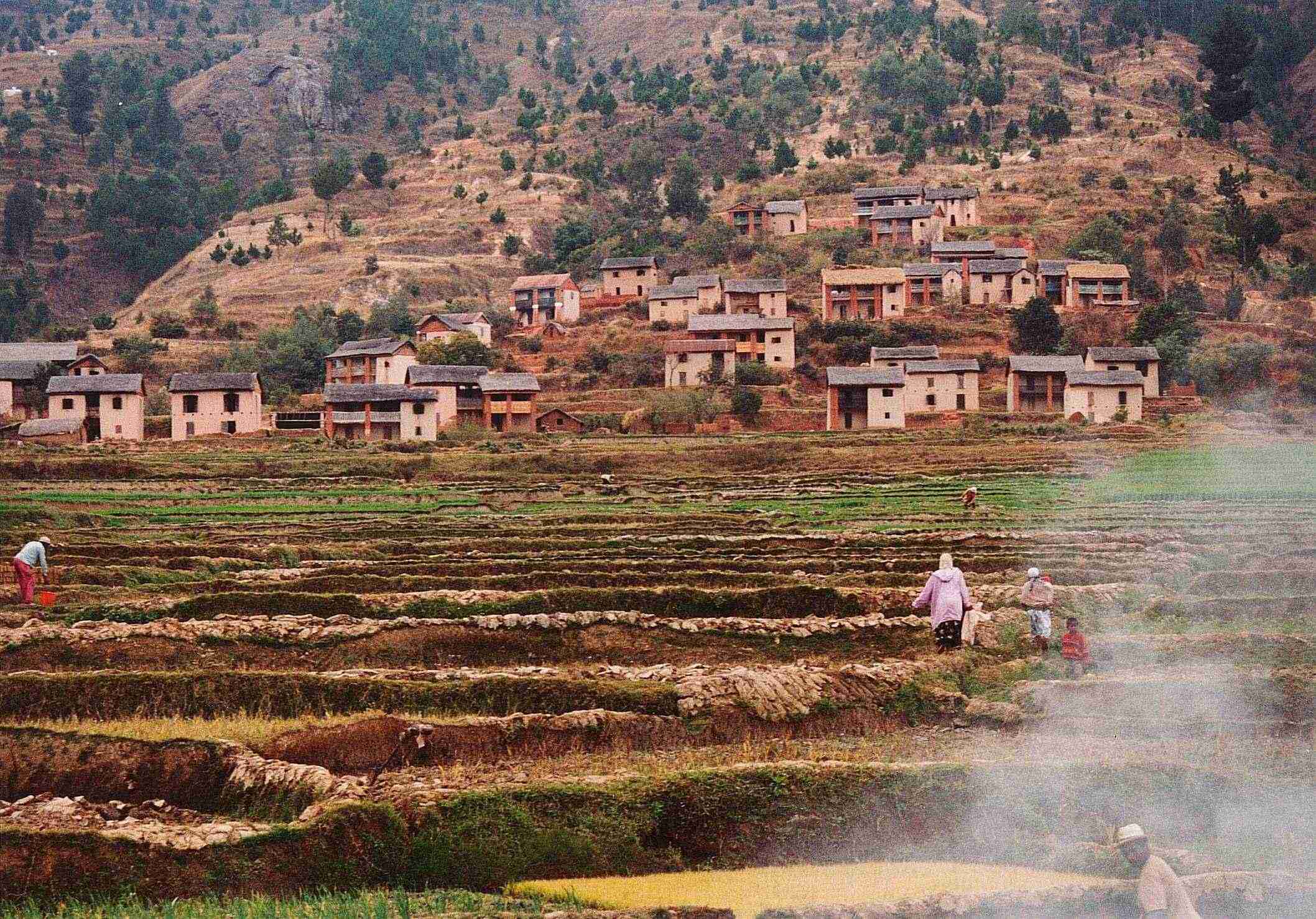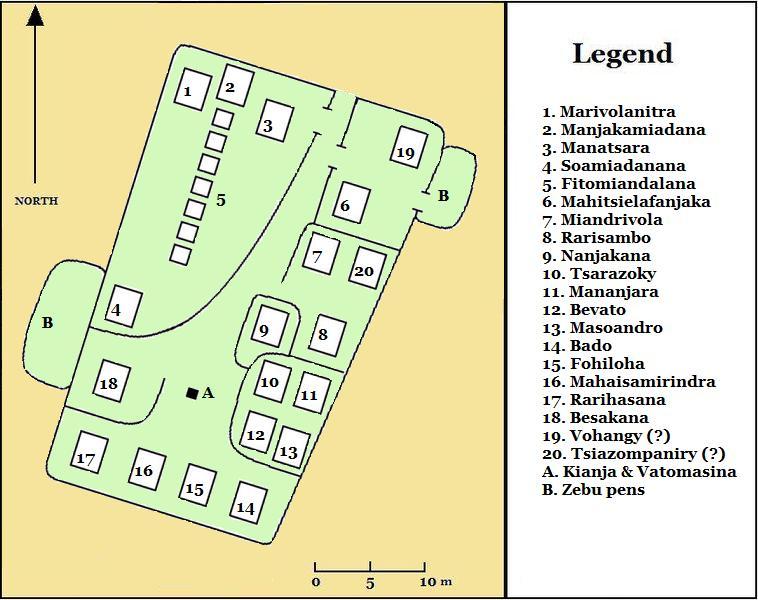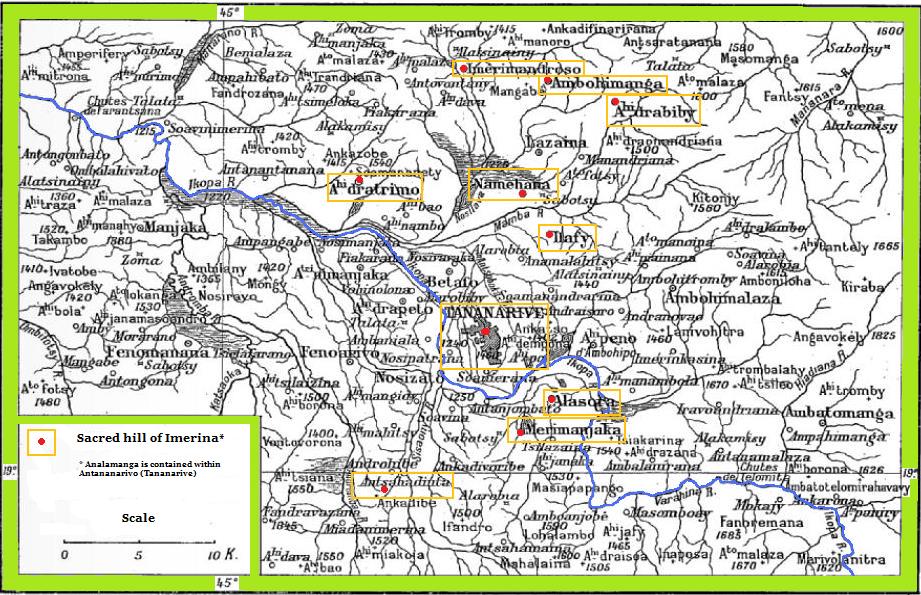|
Andriantsitakatrandriana
Andriantsitakatrandriana (1613-) was the king of Imerina from 1630 to 1650, acceding to the throne upon the death of his father, Andrianjaka. He took two wives: the first, Ravololontsimitovy, gave birth to his first son and successor Andriantsimitoviaminandriandehibe, while his second wife, Rafoloarivo, gave birth to a son named Andriamanjakatokana. During his reign, he chased his second wife and son from his territory, and constructed dikes to transform the Betsimitatatra swamps around Antananarivo into vast rice paddies to feed the local population. Reign The chief accomplishment of Andriantsitakatrandriana's reign was the initial transformation of the vast Betsimitatatra swamps surrounding the hill of Analamanga into fertile rice paddies through the construction of dikes. Until his time, only ''zozoro'' (an indigenous sedge), rushes, and clusters of trees grew in the marshy lands around the capital city of Antananarivo, which his father had at last wrested from its Vazimba occupa ... [...More Info...] [...Related Items...] OR: [Wikipedia] [Google] [Baidu] |
Andrianjaka
Andrianjaka reigned over the Kingdom of Imerina in the central highlands region of Madagascar from around 1612 to 1630. Despite being the younger of King Ralambo's two sons, Andrianjaka succeeded to the throne on the basis of his strength of character and skill as a military tactician. The most celebrated accomplishment of his reign was the capture of the Twelve sacred hills of Imerina#Hill of Analamanga, hill of Analamanga from a Vazimba king. There he established the fortified compound (''rova'') that would form the heart of his new capital city of Antananarivo. Upon his orders, the first structures within this fortified compound (known as the Rova of Antananarivo) were constructed: several traditional royal houses were built, and plans for a series of royal tombs were designed. These buildings took on an enduring political and spiritual significance, ensuring their preservation until being destroyed by fire in 1995. Andrianjaka obtained a sizable cache of firearms and gunpowder ... [...More Info...] [...Related Items...] OR: [Wikipedia] [Google] [Baidu] |
Andriantsimitoviaminandriandehibe
Andriantsimitoviaminandriandehibe ("the noble without equal among great nobles") was the King of Imerina in the central highlands of Madagascar from 1650 to 1670. He acceded to the throne on the death of his father, King Andriantsitakatrandriana. He had three wives: Ratompoimbahoaka of Ambohimalaza, Princess Ramahafoloarivo (granddaughter of King Andrianjaka), and Princess Rafaravavy Rampanananiamboninitany. He is responsible for establishing the rice paddies of the Betsimitatatra that lie to the west of Ankadimbahoaka.Callet (1908), p. 532 Reign Andriantsimitoviaminandriandehibe pledged to continue his father's work to transform the Bestimitatatra swamps into rice paddies to feed the growing population of Imerina. He selected two of his sons to oversee the labor. The two princes challenged one another to see who could complete their dike fastest. The king proceeded to traditionally divide the territory into northern and southern halves along the Ikopa River and assigned Andrianjaka ... [...More Info...] [...Related Items...] OR: [Wikipedia] [Google] [Baidu] |
List Of Imerina Monarchs
This article lists the Imerina monarchs, from the earliest origins of the Merina monarchy until the French conquest of the Merina Kingdom during the Second Madagascar expedition. Early monarchs in the Merina line Below is a list of the line of Merina monarchs that ruled in the Central Highlands of Madagascar and from whom were issued the first true monarchs of a united Madagascar in the 19th century. Before the uniting of Madagascar, succession was based on the current monarch's designation of an heir, typically from among his or her own children. As such, the list below represents a direct genealogical line from the last 19th-century queen of Madagascar to some of the earliest known rulers identified in the 15th century or before. Prior to the 16th century, detailed information about the names and dates of Merina rulers becomes less consistent. Genealogy in this early period are derived primarily from oral history, while later names and dates are verifiable from primary source ... [...More Info...] [...Related Items...] OR: [Wikipedia] [Google] [Baidu] |
Rova Of Antananarivo
The Rova of Antananarivo ( mg, Rovan'i Manjakamiadana ) is a royal palace complex (''rova'') in Madagascar that served as the home of the sovereigns of the Kingdom of Imerina in the 17th and 18th centuries, as well as of the rulers of the Kingdom of Madagascar in the 19th century. Its counterpart is the nearby fortified village of Ambohimanga, which served as the spiritual seat of the kingdom in contrast to the political significance of the Rova in the capital. Located in the central highland city of Antananarivo, the Rova occupies the highest point on Analamanga, formerly the highest of Antananarivo's many hills. Merina king Andrianjaka, who ruled Imerina from around 1610 until 1630, is believed to have captured Analamanga from a Vazimba king around 1610 or 1625 and erected the site's first fortified royal structure. Successive Merina kings continued to rule from the site until the fall of the monarchy in 1896, frequently restoring, modifying or adding royal structures within ... [...More Info...] [...Related Items...] OR: [Wikipedia] [Google] [Baidu] |
Merina Kingdom
The Merina Kingdom, or Kingdom of Madagascar, officially the Kingdom of Imerina (–1897), was a pre-colonial state off the coast of Southeast Africa that, by the 19th century, dominated most of what is now Madagascar. It spread outward from Imerina, the Central Highlands region primarily inhabited by the Merina ethnic group with a spiritual capital at Ambohimanga and a political capital west at Antananarivo, currently the seat of government for the modern state of Madagascar. The Merina kings and queens who ruled over greater Madagascar in the 19th century were the descendants of a long line of hereditary Merina royalty originating with Andriamanelo, who is traditionally credited with founding Imerina in 1540. In 1883, France invaded the Merina Kingdom to establish a protectorate. France invaded again in 1894 and conquered the kingdom, making it a French colony, in what became known as the Franco-Hova Wars. History Hova-Vazimba conflict Madagascar's central highlands w ... [...More Info...] [...Related Items...] OR: [Wikipedia] [Google] [Baidu] |
Twelve Sacred Hills Of Imerina
The twelve sacred hills of Imerina are hills of historical significance to the Merina people of Madagascar. Located throughout Imerina, the central area of the highlands of Madagascar, the sites were often ancient capitals, the birthplaces of key public figures, or the tomb sites of esteemed political or spiritual leaders. The first set of sacred sites was designated by early 17th-century king Andrianjaka. The notion was re-sanctified under late 18th-century king Andrianampoinimerina, who replaced several of the earlier sites with new ones. More than 12 sites were thus designated as sacred over time, although the notion of twelve sacred hills was perpetuated because of the significance of the number 12 in Malagasy cosmology. Today, little concrete evidence of the former importance of many of these sites remains, but the significant archeological and cultural heritage of several of the sites has been preserved. The historic significance of the sites is best represented by the Rova ... [...More Info...] [...Related Items...] OR: [Wikipedia] [Google] [Baidu] |
Antananarivo
Antananarivo ( French: ''Tananarive'', ), also known by its colonial shorthand form Tana, is the capital and largest city of Madagascar. The administrative area of the city, known as Antananarivo-Renivohitra ("Antananarivo-Mother Hill" or "Antananarivo-Capital"), is the capital of Analamanga region. The city sits at above sea level in the center of the island, the highest national capital by elevation among the island countries. It has been the country's largest population center since at least the 18th century. The presidency, National Assembly, Senate and Supreme Court are located there, as are 21 diplomatic missions and the headquarters of many national and international businesses and NGOs. It has more universities, nightclubs, art venues, and medical services than any city on the island. Several national and local sports teams, including the championship-winning national rugby team, the Makis are based here. Antananarivo was historically the capital of the Merina peop ... [...More Info...] [...Related Items...] OR: [Wikipedia] [Google] [Baidu] |
Vazimba
The Vazimba (Malagasy ), according to popular belief, were the first inhabitants of Madagascar. While beliefs about the physical appearance of the Vazimba reflect regional variation, they are generally described as smaller in stature than the average person, leading some scientists to speculate that they may have been a pygmy people (and therefore a separate Malagasy ethnic group) who migrated from the islands that constitute modern-day Indonesia and settled in Madagascar over the course of the period between 350 BCE–500 CE. Scientific evidence confirms the first arrival and subsequent increase of human settlers on the island during this period, but the pygmy theory has not been proven. Stories about the Vazimba form a significant element in the cultural history and collective identity of the Malagasy people, ranging from the historical to the supernatural, inspiring diverse beliefs and practices across the island. They have analogs in some other Austronesian cultures, inclu ... [...More Info...] [...Related Items...] OR: [Wikipedia] [Google] [Baidu] |
Mada03-0032
Mada ( sa, मद) is a term used in both Hindu theology and mythology. It is one of the Arishadvargas. It refers to one of the six enemy of the mind or a vice according to the Hindu scriptures. It is the Hindu equivalent of Pride from the seven deadly sins from the Christian Theology. Hindu theology According to the Hindu theology, it signifies negative attributes such as "arrogance, excessive pride, obstinacy, stubborn mindedness".Shankarcharyara Granthabali, Basumati publication (Kolkata: 1995) volume 3 It is seen as a major obstacle to attaining moksha, or salvation. If one bears ''mada'' towards another person, they cannot attain moksha. The presence of ''Mada'' in a person leads to ignorance which in turn leads to the corruption of the mind. According to Hindu scriptures, mada is often manifested due to a variety of reasons. Hindu mythology In Hindu mythology, Mada is a gigantic Rakshasa (demon or monster) from the Hindu text, Mahabharata. It is created by sage Chyava ... [...More Info...] [...Related Items...] OR: [Wikipedia] [Google] [Baidu] |
Hasina (Madagascar)
Hasina is the concept of sanctity and imbued authority in the traditional culture of Madagascar. An individual is believed to be imbued with ''hasina'', which can be augmented or diminished by their actions or by the tribute or authority conceded to them by others. Rulers in traditional society were the ultimate embodiment of ''hasina'', whereas community leaders and heads of families possessed relatively less. The same term, ''hasina'', was used to describe tributes given to political leaders, which in the 19th century Kingdom of Imerina The Merina Kingdom, or Kingdom of Madagascar, officially the Kingdom of Imerina (–1897), was a pre-colonial state off the coast of Southeast Africa that, by the 19th century, dominated most of what is now Madagascar. It spread outward from I ... typically took the form of a silver coin and accompanying prayer. References Malagasy culture Malagasy words and phrases {{Madagascar-stub ... [...More Info...] [...Related Items...] OR: [Wikipedia] [Google] [Baidu] |
Ilafy
Ilafy is a town and commune ( mg, kaominina) in Madagascar. It belongs to the district of Ambatondrazaka, which is a part of Alaotra-Mangoro Region. The population of the commune was estimated to be approximately 13,000 in 2001 commune census. Primary and junior level secondary education are available in town. The majority 96% of the population of the commune are farmers, while an additional 1% receives their livelihood from raising livestock. The most important crop is rice, while other important products are cassava, sweet potatoes and bambara groundnut. Industry and services provide employment for 0.5% and 1.5% of the population, respectively. Additionally fishing employs 1% of the population. Ilafy is of historical and cultural significance, widely considered one of the twelve sacred hills of Imerina The twelve sacred hills of Imerina are hills of historical significance to the Merina people of Madagascar. Located throughout Imerina, the central area of the highlands of M ... [...More Info...] [...Related Items...] OR: [Wikipedia] [Google] [Baidu] |
Malagasy Monarchs
Malagasy may refer to: *Someone or something from Madagascar *Malagasy people *Malagasy language *Malagasy Republic *Related to the culture of Madagascar See also *Madagascar (other) Madagascar is an island country located off the eastern coast of Africa. Madagascar may also refer to: Places * Geography of Madagascar * Madagascar Plate Entertainment * ''Madagascar'' (1994 film), a Cuban film by Fernando Pérez * ''Madagas ... {{disambiguation Language and nationality disambiguation pages ... [...More Info...] [...Related Items...] OR: [Wikipedia] [Google] [Baidu] |




